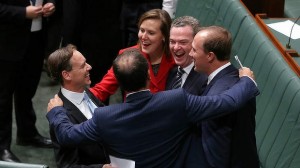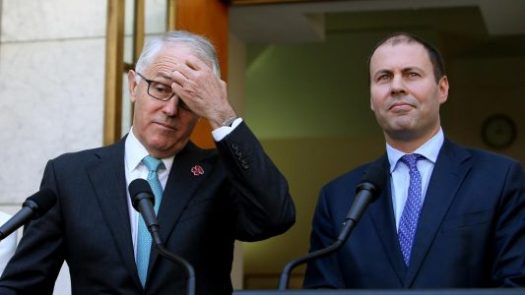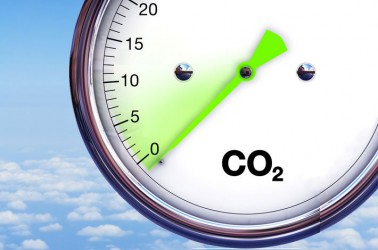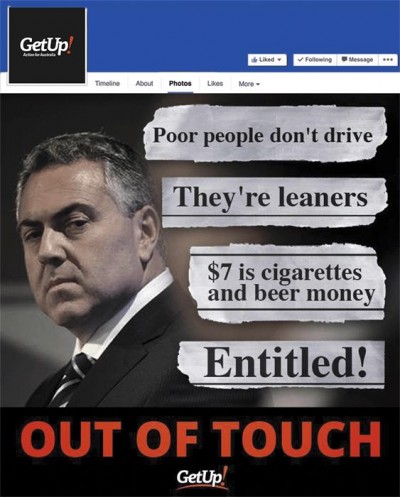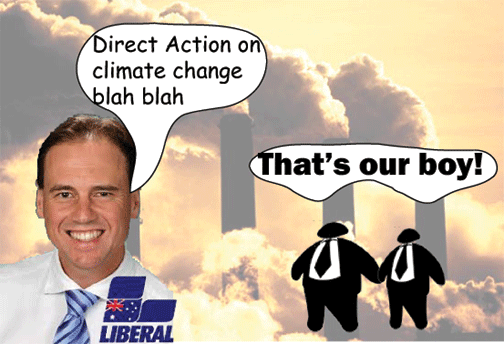In an interview on Lateline in October last year, Greg Hunt said that the carbon price “doesn’t work”, “doesn’t do the job” and is “a just hopeless means of achieving the outcome.”
In defending his move to disband the Climate Change Commission, the Climate Change Authority, the Energy Security Fund, the Clean Energy Finance Corporation and ARENA, Hunt said
“At the governmental level, the primary scientific agency is the Bureau of Meteorology. 1,700 staff. I spoke with the director of the Bureau this evening and invited them to provide a scientific briefing, reaffirmed a complete commitment to their independence, to their original research and to the extraordinary capacity that they give to Australia to look at meteorological questions and broader global questions.
The Bureau is the originating scientific agency for meteorological matters in Australia for matters relating to climate and matters relating to climate science. The CSIRO also backs those up. So, they are strong, deep, independent scientific agencies whose independence isn’t just guaranteed under us, but is welcomed.”
He then proceeded to cut $10 million from the BoM, with an anticipated loss of 80 jobs next year, and he cut CSIRO’s funding by $111 million over four years, which will result in 500 job cuts at the nation’s peak scientific organisation.
Hunt went on to say
“we have bipartisan support for the science. We have bipartisan support for the targets. The disagreement is about the carbon tax and the mechanism because emissions go up, not down under the carbon tax and because it does enormous damage to our cost of living and our economy by being an electricity tax. In short, it doesn’t work, but it does do damage.”
Figures released last week revealed that the annual growth of cost of living for all households slowed over the past three months (employee and age pensioner households increased by just 1.9%), largely due to the end of the carbon price in June.
But as Greg Jericho points out, any broadening of the GST base to include food, or an interest rate rise, or fuel indexation, will quickly wipe out any gains made by removing the carbon tax which was only slated to run for another year with a fixed price.
While the cost of living increase may have slowed, two new studies show that brown coal and black coal generation has jumped sharply in the four months since the carbon price was dumped by the Abbott government. The share of coal has gone up from 69.6% of sent out electricity in June to 76.4% in October.
And emissions have also jumped sharply, with one study from the Melbourne Energy Institute saying “emissions intensity’ has already jumped an “unprecedented” 10 per cent, and another saying that Australia’s aggregate emissions could rise more than 10 per cent over the year, after falling nearly that much while the carbon price was in place.
Danny Price, from Frontier Economics who helped the Government develop its direct action plan, was also interviewed on Lateline in November last year.
He insisted that penalties for industries that increase their emissions is a crucial part of the plan.
“The direction action policy has always had a penalty included in it. It’s been a consistent feature of direct action from the very first document, that’s been put out on direct action.
The Government, of course, hasn’t yet put anything out about how the penalties will work or the baselines will work which will be a challenge for the Government and they’re the two, you know, most difficult issues for the Government to deal with. But I guess we’ll get to see what the form of the penalty is going to be.”
But not for a while. Nick Xenophon insisted on a safeguards mechanism that will be negotiated in the next 12 months that will determine how tight emissions limits will be and the penalties for exceeding them. Strangely, the emissions reduction fund auctions will apparently begin before the baselines are determined.
“I can announce this today, that the first auctions under the Emissions Reduction Fund, after having spoken to the Clean Energy Regulator on Friday, will be held in the first quarter of next year,” Mr Hunt said on Sunday.
When asked how much Direct Action would cost to achieve the 5% reduction target by 2020, Mr Price, who is the government’s expert on this, said
“Well, I don’t know yet because it will depend very much on where the Government sets the baselines, the nature of the penalties that are applied, but in the order of between $7 billion to $10 billion but probably on the lower end of that range.
The now Government, but then Opposition, had said initially that they had funds available for up to $10.5 billion till 2020. My understanding is that there are funds beyond the forward estimates. And that would be the extra $4.5 billion plus the 2.55 would be very consistent with what I’ve just said I think the costs are likely to be.”
The budget text states that the government will provide an “initial” $2.55 billion to establish the Emissions Reduction Fund, which is consistent with what the Coalition had promised prior to the election over the first four years of the scheme.
Yet the table which accompanies this text listing the hard dollars provides a contradictory and highly confusing story. It outlines a total funding allocation over the next four years of just under $1.15 billion.
A spokesperson for Greg Hunt said that the Clean Energy Regulator is free to at least commit to abatement purchasing contracts up to $2.55 billion over the next four years. However, they expect that because the regulator will only pay for abatement once it is delivered, the expenditure of the $2.55 billion will be spaced out over a period beyond the forward estimates period to 2017-18.
Market analysts Reputex suggest the $2.5 billion fund may get Australia about a third of the way to our low 5% target, but not much more.
Price stressed that Direct Action requires investors who, in turn, need certainty about legislation and regulation.
“this has to be a policy orientated towards investors and I just can’t see that investors are going to invest in a scheme [carbon pricing] where the Government can and will change the price to suit the politics and it could render their investments completely stranded, redundant.”
I wonder how he feels about the Coalition’s backflip on the Renewable Energy Target leading to the decimation of the renewable energy industry and the loss of billions of dollars investment that would have contributed towards meeting our emission reduction target whilst creating new jobs.
Greg Hunt told Emma Alberici
“I’m the Environment Minister and my job is to make sure that we do two things: that we understand the challenge and we respond to the challenge. And then the third thing which goes beyond that is to make sure that our actions are sensible and prudent and real.”
Hunt said on Monday that cleaning up existing power stations was the “the best thing” thing the government could do to reduce emissions, and pointed to the CSIRO’s direct injection carbon engine (DICE) technology as a way to reduce emissions from brown coal.
But, as pointed out in Crikey, rather than being a “major CSIRO research project”, there is a small team of two to four well-intentioned scientists and engineers working out of the CSIRO’s energy labs in Newcastle, running a 4-litre, single-cylinder diesel engine on coal, on a shoestring budget, struggling to find industry partners. The technology is drastically underfunded, unavailable at scale, and has a colourful history of unsuccessful research sponsored for very many years by miner Travers Duncan who has been part of the ICAC investigation into White Coal and Eddie Obeid. Any significant commercial roll-out is decades away.
Hunt should also know that the recent apparent breakthrough in capture and storage of coal emissions – the Canadian Boundary Dam Project – was hideously expensive. They spent $US1.24 billion to retrofit an existing power station to produce 110 megawatts of power to the grid. Assuming 80 per cent utilisation that’s more than $US14 million per effective megawatt, and you’ve got fuel costs on top of that.
By comparison a wind farm assuming 40 per cent utilisation (what newly constructed wind farms in Australia can achieve) comes in at $US5 million or so per effective megawatt with no fuel cost. Also, it can be built in one year instead of four or five, with that saving in construction time adding up to lot of avoided bank loan interest which weighs on the clean coal project.
In the budget the government cut $459.3m over three years from its carbon capture and storage flagship program, leaving $191.7m to continue existing projects for the next seven years, so one wonders just how serious they are about it.
If the government sticks to its suggested (but not confirmed) budget of $4.95 billion up to 2020, they can only afford to spend an average of $11.75 per tonne of CO2. At that price they may achieve a few million tonnes of abatement, but leading carbon market analysts and brokers including Bloomberg New Energy Finance, SKM-MMA and RepuTex suggest that the government has Buckley’s chance of reaching its target of 421 million tonnes with the allocated budget.
At the start of his prime ministership Tony Abbott said, “We hope to be judged by what we have done rather than by what we have said we would do.”
Rest assured Tony, the whole world is judging these actions.
